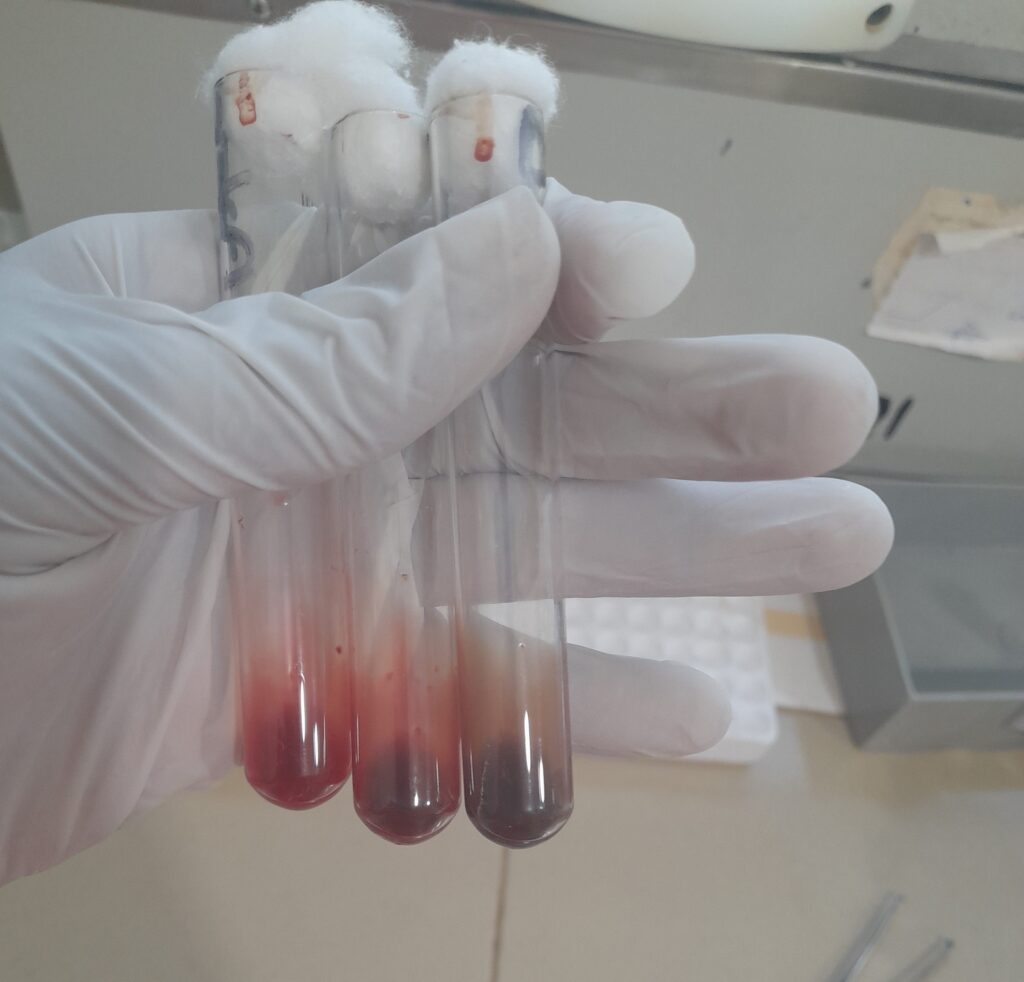What is the G6PD test? All you need to know about the principle and procedure
Function and Deficiency of G6PD
Glucose-6-Phosphate Dehydrogenase is an enzyme that helps in the production of NADPH. During the Pentose Phosphate Pathway, G6PD converts Gluose-6- phosphate to 6-Phosphoglucoolactone. This is made possible by removing Hydrogen from G6P and adding it to NADP+ to form NADPH. NADPH serves as a cofactor of the enzyme glutathione reductase to help in the production of glutathione. The Glutathione then protects Red Blood Cells from reactive oxygen species like hydrogen peroxide and superoxide anions. Glutathione protects RBCs from reactive oxygen to prevent the lysing of RBCs.
G6PD deficiency is a hereditary condition that leads to an insufficient amount of G6PD in the blood. Deficiency in G6PD will lead to halt the Pentose Phosphate Pathway and lead to a decrease or no production of NADH. Once there is no NADPH, Glutathione cannot be produced to protect the RBC’s from reactive oxygen species. These chemical will than attack the RBC’s which will eventually have an adverse effect of your health.
G6PD deficiency is an X-linked recessive trait and is mostly found in men. This is because women have two X-chromosomes and men have one. This makes it difficult for a woman to suffer from this deficiency. To detect the sufficiency of G6PD, a G6PD test has to be conducted first. Read on the principle of the Gazelle Hb variant.
Signs and Symptoms of G6PD Deficiency
Although some people with G6PD may show no signs and symptoms, others may have adverse effects and suffer from hemolytic anemia. This is because red blood cells produced will have short life spans due to destruction by reactive oxygen species like peroxides. Lysing of RBCs before their lifespan will then increase bilirubin levels in the body. An increase in bilirubin levels will then cause jaundice. Below are some signs and symptoms of G6PD deficiency
- Jaundice in children will persist for a long time
- Short of breath
- Fatigue
- Dizziness
One can live with G6PD by adhering to some precautions. People with insufficient G6PD should not take in some foods and drugs. This may be the precursor for hemolytic anemia because it will introduce more reactive oxygen species in the blood.
Fava beans, sulfonamides, aspirin, and levofloxacin, are some examples of food and drugs a G6PD deficient should avoid. Products like naphthalene balls and aniline dyes should also not be used.
Principle of the G6PD Test
The G6PD test involves the use of two reagents that helps in detecting the levels of G6PD in the blood. The two reagents are methylene blue and sodium nitrite.
Sodium nitrite converts hemoglobin to methemoglobin by the oxidation of Fe2+ to Fe3+. This accounts for the dark-brown color. Just like a rusted iron
Methylene blue converts methemoglobin back to hemoglobin by the reduction of Fe3+ to Fe2+ in the presence of Glucose-6-Phosphate Dehydrogenase which serves as a precursor for the pentose phosphate pathway. Red about the principle of the snibe maglumi 800.
Materials and Apparatus Needed for the G6PD Test
Anticoagulated blood, water, micropipette, pipette tips, test tubes, cotton, timer, test tube rack, and water bath.
Procedure Of G6PD Test
- About 4mls of blood is drawn into a glycolytic inhibitor tube and labeled. This tube is used because, it contains fluoride oxalate which prevents glycolysis in the drawn blood thereby, maintaining glucose in the blood.
- Pick three test tubes and label them as Test control (T), Positive control (P), Negative control (C), and the ID of the patient.
- Using a micropipette, pipette 50µl of sodium nitrite, 50µl methylene blue, and 1000µl of whole blood in test tube T.
- In test-tube P, pipette 50µl of sodium nitrite and 1000µl of whole blood.
- In test-tube C, pipette only 1000µl of whole blood
- Swirl the tube to mix the content and cork each tube with cotton.
- Place the test tubes in a water bath for 3 hours at 37 degrees Celsius.
| Blood/reagent | Test tube ‘T’ | Test tube ‘P’ | Test tube ‘C’ |
| Blood | 1000µl | 1000µl | 1000µl |
| Methylene blue | 50µl | – | 50µl |
| Sodium Nitrite | 50µl | 50µl | – |
Observation and Interpretation Results

After three hours, the colors in the tubes are compared to know the levels of G6PD in the blood.
If the color of the blood in tube T is the same as the color of the blood in tube C, it is recorded as ‘No Deficiency or Normal’-there is a sufficient amount of G6PD level. The color remains red.
If the color of the blood in tube T is the same as the color of the blood in test tube P, it is recorded as ‘Deficient’- It indicates absence of G6PD. The color of the blood turns dark.
If the color in tube T is intermediate to the colors in tubes P and N, it is recorded as ‘Partial Deficiency”. This is mostly seen in females. This shows that there is insufficient amount of G6PD.
Another way of observation is by pipetting an aliquot of blood from each test tube into separate test tubes containing water to observe the color difference.
Precautions
- The test should be done early when it is collected in an EDTA tube since glucose may decrease due to glycolysis and may produce false positives.
- Test tubes should be labeled clearly.
- Reagents should be refrigerated between 2-8 degrees Celsius.
- Make sure that the micropipette is well-calibrated.
- Clean and dry test tubes and pipette tips should be used.